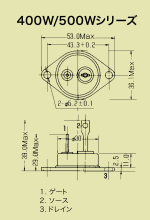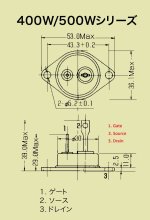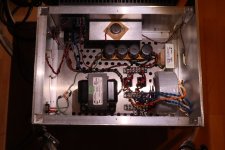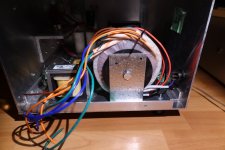Thanks.
I wasn't trying to get you to use it! I am sorry that I assumed everyone was familiar with the thing.
Just wondered if you might have cautioned against NOT trying it.
It is not always more expensive - I am using two ST dual rectifiers that cost $25.00 each! These were recommended by Mr. Yazaki of SPEC CORP. I have found they do sound better than the usual.
Just thinking about the heat and getting an extra volt or two of B-.
I will give it a try and let you know what difference it makes, if any.
Always appreciate and respect your opinion.
Take care,
I wasn't trying to get you to use it! I am sorry that I assumed everyone was familiar with the thing.
Just wondered if you might have cautioned against NOT trying it.
It is not always more expensive - I am using two ST dual rectifiers that cost $25.00 each! These were recommended by Mr. Yazaki of SPEC CORP. I have found they do sound better than the usual.
Just thinking about the heat and getting an extra volt or two of B-.
I will give it a try and let you know what difference it makes, if any.
Always appreciate and respect your opinion.
Take care,
Cost is relative. The bridge rectifiers that I use are good for 25A and 600V or more, and they cost me less than $5 Canadian each.
I am happy with the sound of my amplifiers. Can they sound better? Probably. Will they sound better with different rectifiers? I don't know. 🙂
I am happy with the sound of my amplifiers. Can they sound better? Probably. Will they sound better with different rectifiers? I don't know. 🙂
Something to explore in the future.
I figure these templates are good for our lifetimes - so we continue to refine them.
I do hear a difference with the limited experience I have had - mainly between the stock FW ones and the ST 6110 I have used. I started using them in the SIT 1s and J2s.
These get quite warm in my amplifiers even with a failry substantial heat sink with is an I beam aluminum extrusion- probably due to the fact I think they do have more voltage drop in exchange for their "softness" which is part of their specification. https://www.mouser.com/datasheet/2/389/stth6110tv-1851743.pdf
I see I exaggerated the cost a bit. Still more expensive than an Lt4320 set up.
Take care and thanks for your time as always.
I figure these templates are good for our lifetimes - so we continue to refine them.
I do hear a difference with the limited experience I have had - mainly between the stock FW ones and the ST 6110 I have used. I started using them in the SIT 1s and J2s.
These get quite warm in my amplifiers even with a failry substantial heat sink with is an I beam aluminum extrusion- probably due to the fact I think they do have more voltage drop in exchange for their "softness" which is part of their specification. https://www.mouser.com/datasheet/2/389/stth6110tv-1851743.pdf
I see I exaggerated the cost a bit. Still more expensive than an Lt4320 set up.
Take care and thanks for your time as always.
Yes, there are many ways to build an amplifier, and as a diyer, you are free to explore new ideas. That is the beauty of diy.
For me, I have tried to learn and understand the construction of amplifiers. Since I have quite sensitive speakers, I have tried to learn and understand how to build a quiet amplifier. My amplifiers and preamplifiers are dead quiet when connected to my 103dB speakers so I am quite happy to hear (or not hear) that, although I have been told here on diyAudio by a member that I am "just trying to stubbornly prove something here but lack understanding of the current flows in this case" when I described how I wire my amplifiers. And further more he wrote, "All amplifiers in the world do not adhere to what you are suggesting........".
So for me, the important thing is to be able to build amplifiers and preamplifiers that are quiet.
Of course good sound is important too, and that is the reason I have tried various types of amplifiers using SITs. I have tried to make great sounding SIT amplifiers with regular parts, to highlight the SITs. I am happy with their sound that I have no urge to try to improve them with esoteric parts. 🙂
For me, I have tried to learn and understand the construction of amplifiers. Since I have quite sensitive speakers, I have tried to learn and understand how to build a quiet amplifier. My amplifiers and preamplifiers are dead quiet when connected to my 103dB speakers so I am quite happy to hear (or not hear) that, although I have been told here on diyAudio by a member that I am "just trying to stubbornly prove something here but lack understanding of the current flows in this case" when I described how I wire my amplifiers. And further more he wrote, "All amplifiers in the world do not adhere to what you are suggesting........".
So for me, the important thing is to be able to build amplifiers and preamplifiers that are quiet.
Of course good sound is important too, and that is the reason I have tried various types of amplifiers using SITs. I have tried to make great sounding SIT amplifiers with regular parts, to highlight the SITs. I am happy with their sound that I have no urge to try to improve them with esoteric parts. 🙂
Ben Mah - Could you send me the Gerber files for this project? Just planning ahead. Many thanks! 🙂
OK, I finally get around to assemble the first monoblock hopefully this weekend. I have all parts at home now (except possibly for the soft start capacitor). @Ben Mah, thank you very much again for all your help. I have attached another drawing of the circuit and I think I have corrected all the parts that you mentioned. I'd appreciate if you could have a look. Two more questions:
Adrian

- What is a good range for the capacitor in the soft start (so that I possibly won't have to order another part)
- Can you also confirm that my gate, source, drain labelling for the THF 51-S is correct
Adrian
Attachments
Last edited:
Hi Adrian,
I was wondering how your build was coming along. It's good to see that you are nearly there.
I have looked at you diagram and it looks correct. The pins of the THF-51S are correct.
Since the power transformer wires are the same colours for each pair of primary windings and secondary windings, be sure to double check that the correct pairs of wires are selected for each winding (check each red/black pair and each blue/green pair for continuity).
I used CL-60 thermistors in series with the power transformer primary windings for soft start. I have never used an active soft start system so I have no idea what capacitor value would be suitable.
Building and power-up tips here: https://www.diyaudio.com/community/...-choke-loaded-2sk180-lamp.366312/post-7270513
I was wondering how your build was coming along. It's good to see that you are nearly there.
I have looked at you diagram and it looks correct. The pins of the THF-51S are correct.
Since the power transformer wires are the same colours for each pair of primary windings and secondary windings, be sure to double check that the correct pairs of wires are selected for each winding (check each red/black pair and each blue/green pair for continuity).
I used CL-60 thermistors in series with the power transformer primary windings for soft start. I have never used an active soft start system so I have no idea what capacitor value would be suitable.
Building and power-up tips here: https://www.diyaudio.com/community/...-choke-loaded-2sk180-lamp.366312/post-7270513
Attachments
Yes, slow progress, I spent some time on sourcing aluminium for the case and had some trials and tribulations cutting it 🙂


- I've updated the diagram with the cl60 for input windings
- Digikey had the insulator pads backordered, so I plan to use a 1mm non-conductive thermal silicon pad (14.8W/m-k) which I got off of Amazon and is intended for GPUs and CPUs, I hope that will work, I'll monitor the SIT temperature
- The heatsink from diyaudiostore has the correct pre-drilled m3 threads to mount the THF-51S. What would you recommend for mounting it onto the heatsink: nylon screws or metal screws with an insulating flanged washer?
- I've also attached a picture of my current layout plan. The space in the back is possibly add an FE2022. Does this look OK, or should I reconsider?
Hi Adrian,
The insulator pads will probably work. Monitor the temperature as you mentioned.
I would use steel screws with nylon shoulder washers.
I think you should reconsider the layout. Have a look at my amplifier. I have the AC and power on one side of the chassis and the heatsink with the audio electronics on the other side, to keep AC and power transformer away from the audio section. I would also recommend mounting the power transformer vertically at the front of the chassis. I used a Simpson Strong-tie A24 angle (https://www.homedepot.com/p/Simpson...-in-x-2-1-2-in-Galvanized-Angle-A24/100375162) to mount the transformer.
Mount the THF-51S at mid-length of the heat sink, at about 1/3 of the height from the bottom of the heat-sink. Are there existing holes in the heat sink that would meet those requirements?
I suggest mounting the amplifier PCB on the heat sink, between the front of the chassis and the SIT, and mount the FE PCB on the heat sink, between the back of the chassis and the SIT.
Take a good look at the picture of my amplifier. Note that wires are tightly twisted. AC power wires are located against one side of the chassis, as far away from the audio circuitry as possible. AC input is located to one side of the back panel and audio input and output are at the opposite side of the back panel.
I must add that it is best to keep the power transformer as far away as possible from the audio input jacks and preamp section.
Your layout would mostly work if you move the AC input to the back left and the RCA in and speaker out to the back right. I would still mount the audio PCBs on the heat sinks to keep them far away from AC line and transformer.
The layout of my amplifier is an example that works, but you can explore layouts based on my suggestions and tips.
The insulator pads will probably work. Monitor the temperature as you mentioned.
I would use steel screws with nylon shoulder washers.
I think you should reconsider the layout. Have a look at my amplifier. I have the AC and power on one side of the chassis and the heatsink with the audio electronics on the other side, to keep AC and power transformer away from the audio section. I would also recommend mounting the power transformer vertically at the front of the chassis. I used a Simpson Strong-tie A24 angle (https://www.homedepot.com/p/Simpson...-in-x-2-1-2-in-Galvanized-Angle-A24/100375162) to mount the transformer.
Mount the THF-51S at mid-length of the heat sink, at about 1/3 of the height from the bottom of the heat-sink. Are there existing holes in the heat sink that would meet those requirements?
I suggest mounting the amplifier PCB on the heat sink, between the front of the chassis and the SIT, and mount the FE PCB on the heat sink, between the back of the chassis and the SIT.
Take a good look at the picture of my amplifier. Note that wires are tightly twisted. AC power wires are located against one side of the chassis, as far away from the audio circuitry as possible. AC input is located to one side of the back panel and audio input and output are at the opposite side of the back panel.
I must add that it is best to keep the power transformer as far away as possible from the audio input jacks and preamp section.
Your layout would mostly work if you move the AC input to the back left and the RCA in and speaker out to the back right. I would still mount the audio PCBs on the heat sinks to keep them far away from AC line and transformer.
The layout of my amplifier is an example that works, but you can explore layouts based on my suggestions and tips.
Attachments
Last edited:
Hi Ben, I would like to ask for your Gerber files.
I would like to try your amp with the SCG preamp or a version thereof.
I would like to try your amp with the SCG preamp or a version thereof.
Hi, Can anyone help?
And I would like to build the Choke Loaded 2SK180 L'Amps from Ben.
Can I use the C2M0080120D MOSFET, N-Ch, 1200V, 31.6a, Sic, TO247 WOLFSPEED https://sinuss.nl/products/c2m00801...c-to247-wolfspeed?_pos=1&_sid=d315b794c&_ss=r or AIMW120R045M1XKSA1 MOSFET, N-Ch, 1.2kV, 52A, TO-247 INFINEON https://sinuss.nl/products/aimw120r...a-to-247-infineon?_pos=5&_sid=d4e4c3f4e&_ss=r instead of the SIT transistors?
Thanks
And I would like to build the Choke Loaded 2SK180 L'Amps from Ben.
Can I use the C2M0080120D MOSFET, N-Ch, 1200V, 31.6a, Sic, TO247 WOLFSPEED https://sinuss.nl/products/c2m00801...c-to247-wolfspeed?_pos=1&_sid=d315b794c&_ss=r or AIMW120R045M1XKSA1 MOSFET, N-Ch, 1.2kV, 52A, TO-247 INFINEON https://sinuss.nl/products/aimw120r...a-to-247-infineon?_pos=5&_sid=d4e4c3f4e&_ss=r instead of the SIT transistors?
Thanks
Hi Ben,
Just out of curiousity. Can you please explain the 10000uF at C6? It is in the signalpath. Doesn't this affect the sound negativ? Can this be a lower value?
Sorry, I have no clue about designing an amp...
Just out of curiousity. Can you please explain the 10000uF at C6? It is in the signalpath. Doesn't this affect the sound negativ? Can this be a lower value?
Sorry, I have no clue about designing an amp...
Those devices will not work in this circuit. SITs are depletion mode devices whereas those mosfets are enhancement mode devices.
The 10mF capacitor at the audio out is to block DC voltage from the speaker. Lowering its value reduces the low frequency response.
If you want to build a mosfet follower amplifier, there is Michael Rothacher's Mofo:
https://www.diyaudio.com/community/threads/build-this-mofo.313649/
The 10mF capacitor at the audio out is to block DC voltage from the speaker. Lowering its value reduces the low frequency response.
If you want to build a mosfet follower amplifier, there is Michael Rothacher's Mofo:
https://www.diyaudio.com/community/threads/build-this-mofo.313649/
Last edited:
Thanks for the responce Ben!
It's not that I want to use mosfets necessarily. I found some 2sk180's on ebay... and they were about 90 dollar a piece. I dont want to spend that much without knowing these are good 2sk180's. That's why I came up with mosfets.
I'll take a look at the mofo amp... Does the mofo sound like your 2sk180 amp?
Thanks!
It's not that I want to use mosfets necessarily. I found some 2sk180's on ebay... and they were about 90 dollar a piece. I dont want to spend that much without knowing these are good 2sk180's. That's why I came up with mosfets.
I'll take a look at the mofo amp... Does the mofo sound like your 2sk180 amp?
Thanks!
I need 4 mono blocks to replace my tube amps with 6C33C tubes for my 103dB speakers.. These amps sounded very good! However sinds I moved to a new house the tube ams hummmmmmm. very loud. There are a lot of solarpannels in my neighbourhood. And I found out that I have a DC problem.
I tried a Pass labs f5 amp, and ..no hummm. So transistor amps work better in my new house. But I miss the SET sound. That's what I am looking for.
I tried a Pass labs f5 amp, and ..no hummm. So transistor amps work better in my new house. But I miss the SET sound. That's what I am looking for.
I do not have a Mofo nor have I heard a Mofo so no comment from me.
An alternative is the THF-51S. It is a higher power SIT so it is more versatile, but may be more expensive, or not, but there may be more available for purchase.
However none of the SITs are cheap when compared to mosfets. The SITs behave like single ended triodes. They will not sound exactly like single ended triodes, but they have their own unique sound that most find to be very enjoyable.
From a price point of view, compare the price of a pair of SITs to a pair of 300B, or 45, or 2A3, or 845, or 211, or 811. Even the 6C33C is not inexpensive these days. And these tubes wear out. SITs will not.
An alternative is the THF-51S. It is a higher power SIT so it is more versatile, but may be more expensive, or not, but there may be more available for purchase.
However none of the SITs are cheap when compared to mosfets. The SITs behave like single ended triodes. They will not sound exactly like single ended triodes, but they have their own unique sound that most find to be very enjoyable.
From a price point of view, compare the price of a pair of SITs to a pair of 300B, or 45, or 2A3, or 845, or 211, or 811. Even the 6C33C is not inexpensive these days. And these tubes wear out. SITs will not.
Yes, you are right about the cost...and wear of tubes.
The way you discribe your amp sounds really interesting.
Do you think it is safe to buy THF-51S from ebay?
The way you discribe your amp sounds really interesting.
Do you think it is safe to buy THF-51S from ebay?
I had bought from ebay with no problems. The seller that I had bought from was watanabetomoaoki. He had a perfect 100% review score. However he is no longer at ebay under that name. I see a seller named fet-tokyo with also a rating of 100% with over 500 reviews, and with THF-51S offered. Perhaps that is his new seller name.
- Home
- Amplifiers
- Pass Labs
- 25W Single Ended Hammond 193V Choke Loaded 2SK180 L'Amp



